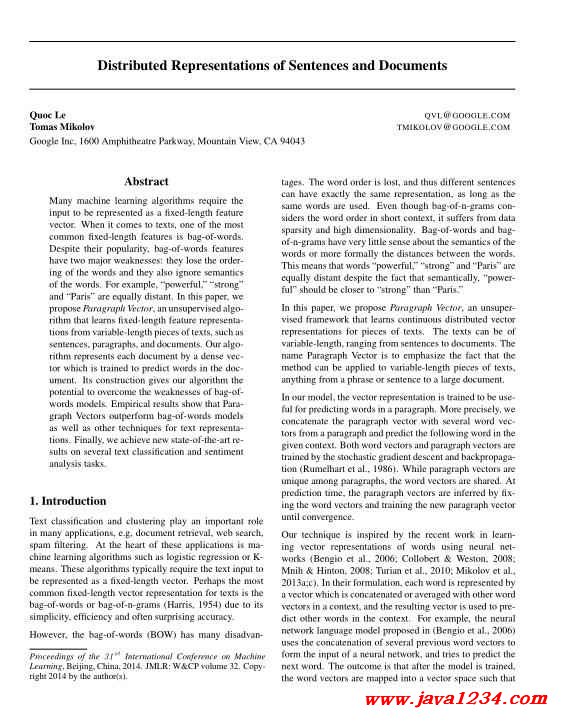| 失效链接处理 |
|
Distributed Representations of Sentences and Documents PDF 下载
本站整理下载:
相关截图:

主要内容:
1. Introduction
Text classification and clustering play an important role
in many applications, e.g, document retrieval, web search,
spam filtering. At the heart of these applications is ma-
chine learning algorithms such as logistic regression or K-
means. These algorithms typically require the text input to
be represented as a fixed-length vector. Perhaps the most
common fixed-length vector representation for texts is the
bag-of-words or bag-of-n-grams (Harris, 1954) due to its
simplicity, efficiency and often surprising accuracy.
However, the bag-of-words (BOW) has many disadvan-
Proceedings of the 31 st International Conference on Machine
Learning, Beijing, China, 2014. JMLR: W&CP volume 32. Copy-
right 2014 by the author(s).
tages. The word order is lost, and thus different sentences
can have exactly the same representation, as long as the
same words are used. Even though bag-of-n-grams con-
siders the word order in short context, it suffers from data
sparsity and high dimensionality. Bag-of-words and bag-
of-n-grams have very little sense about the semantics of the
words or more formally the distances between the words.
This means that words “powerful,” “strong” and “Paris” are
equally distant despite the fact that semantically, “power-
ful” should be closer to “strong” than “Paris.”
In this paper, we propose Paragraph Vector, an unsuper-
vised framework that learns continuous distributed vector
representations for pieces of texts. The texts can be of
variable-length, ranging from sentences to documents. The
name Paragraph Vector is to emphasize the fact that the
method can be applied to variable-length pieces of texts,
anything from a phrase or sentence to a large document.
In our model, the vector representation is trained to be use-
ful for predicting words in a paragraph. More precisely, we
concatenate the paragraph vector with several word vec-
tors from a paragraph and predict the following word in the
given context. Both word vectors and paragraph vectors are
trainedbythestochasticgradientdescentandbackpropaga-
tion (Rumelhart et al., 1986). While paragraph vectors are
unique among paragraphs, the word vectors are shared. At
prediction time, the paragraph vectors are inferred by fix-
ing the word vectors and training the new paragraph vector
until convergence.
Our technique is inspired by the recent work in learn-
ing vector representations of words using neural net-
works (Bengio et al., 2006; Collobert & Weston, 2008;
Mnih & Hinton, 2008; Turian et al., 2010; Mikolov et al.,
2013a;c). In their formulation, each word is represented by
a vector which is concatenated or averaged with other word
vectors in a context, and the resulting vector is used to pre-
dict other words in the context. For example, the neural
network language model proposed in (Bengio et al., 2006)
uses the concatenation of several previous word vectors to
form the input of a neural network, and tries to predict the
next word. The outcome is that after the model is trained,
the word vectors are mapped into a vector space such that
Distributed Representations of Sentences and Documents
semantically similar words have similar vector representa-
tions (e.g., “strong” is close to “powerful”).
Following these successful techniques, researchers have
tried to extend the models to go beyond word level
to achieve phrase-level or sentence-level representa-
tions (Mitchell & Lapata, 2010; Zanzotto et al., 2010;
Yessenalina & Cardie, 2011; Grefenstette et al., 2013;
Mikolov et al., 2013c). For instance, a simple approach is
using a weighted average of all the words in the document.
A more sophisticated approach is combining the word vec-
tors in an order given by a parse tree of a sentence, using
matrix-vector operations (Socher et al., 2011b). Both ap-
proaches have weaknesses. The first approach, weighted
averaging of word vectors, loses the word order in the same
way as the standard bag-of-words models do. The second
approach, using a parse tree to combine word vectors, has
been shown to work for only sentences because it relies on
parsing.
|




 苏公网安备 32061202001004号
苏公网安备 32061202001004号



